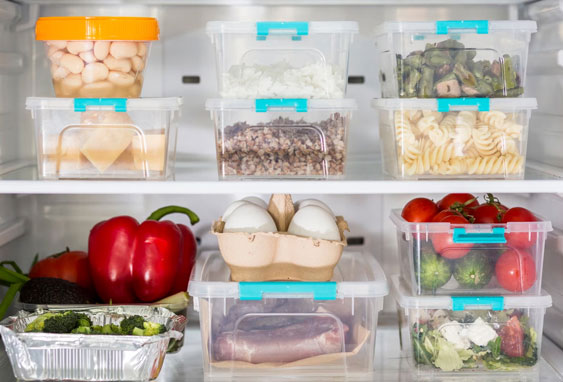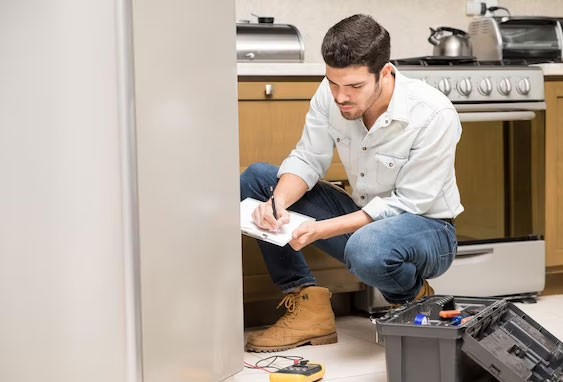Freezer Not Working But Fridge Is Fine? Have you ever opened your freezer to find all your frozen foods had turned to mush? It’s so frustrating! But don’t worry – a malfunctioning freezer while the fridge works is quite common, Here are some tips on how to troubleshoot this!.
There are many reasons why this might be happening. Most are easy to fix!
Let’s look at some of the most typical causes of a broken freezer. Plus, find out solutions to get this electronics working again:
Facts of Freezer Not Cold Enough

- Fact 1: According to a study by RepairClinic, the top reason for a freezer not working is a faulty start relay or overload ($9,149 repair calls in 2018).
- Fact 2: A freezer that is not working but the fridge is fine may be caused by a blocked vent between the freezer and fridge compartment. (Source: Bob Vila)
- Fact 3: In some cases, a freezer not working can be caused by a buildup of frost on the evaporator coils, which can be remedied by defrosting the unit. (Source: Sears Home Services)
- Statistic 1: A survey by HomeServe USA found that 65% of homeowners have experienced a broken appliance, including freezers. (Source: USA Today)
- Trend: Amidst the COVID-19 pandemic, there has been a surge in demand for home appliances, including freezers, causing shortages and longer wait times for repairs. (Source: CTV News)
Why Freezer Not Working But Fridge Is Fine?

Having a problem with your freezer and your refrigerator is fine? A common experience for homeowners. We rely on freezers to save energy and time, yet when they don’t work, it’s so annoying! Let’s explore common problems and how to fix them.
1. Loose Door Seals
Frustrated ’cause your freezer ain’t working, but the fridge is alright? Loose door seals could be the cause.
They’re important for keeping the right temperature in the fridge and freezer. When they’re loose or damaged, cold air escapes and warm air comes in, which affects how the freezer works.
Door seals help keep cool air inside and maintain the right temperature for food. With use and tear, these seals can be cracked or worn, leading to frost and poor sealing – which can stop your freezer working.
2. No Air Circulation
One possibility is not enough air circulating in the freezer. This can create uneven temperatures and make the freezer quit.
It could be causing frost buildup, reduced cooling efficiency or even complete failure. Here are some common causes and what you can do to solve them:
If your fridge’s freezer isn’t working but the fridge is, fan motor failure is likely the cause. Signs of this include poor air circulation in the freezer which stops food from cooling/freezing.
3. Dirty Condenser Coils
If your freezer’s not working, but your fridge is alright, check your condenser coils. These coils sit at the back of the freezer and help cool it down. If they’re blocked or dirty, they won’t do their job well. Here’s why:
- Neglect: If you haven’t kept up with maintenance, dirt will build up. To keep clean coils, make sure to add cleaning them to your regular routine.
- Poorly sealed: If the door isn’t sealed properly, air can get in and make ice on the coils. This can mess up cooling and even damage the compressor. Replace the door seal if needed.
- Cleaning: Cleaning the condenser coils is easy. All you need is a vacuum and a brush. This will save time and money.
- Evaporator fan: If the freezer isn’t cold enough or the fan isn’t running, the coils can freeze. Check the fan to make sure it’s working.
With clean, working condenser coils, your freezer can keep food cold. Don’t wait for it to stop working. With regular maintenance, you can prevent problems.
Pro tip: If you’re not sure how to clean the coils, call a professional. A quick service call can save you from costly repairs. Check also: Kenmore Refrigerator Not Cooling.
4. Faulty Start Relay
Ever walk to your fridge and find the freezer not working, but the fridge is? It’s a worry for anyone who stores frozen food. The most common reason?
A faulty start relay. In this article, we learn what start relays are, how they work, and how to fix when yours is broken. Get your freezer back in action fast!
If your freezer isn’t working, yet the fridge is fine, it could be due to a faulty Start Relay. Here are some signs that indicate a problem:
- Clicking sound: If you hear a clicking noise from the back of your freezer, it’s likely a Start Relay issue. This relay is responsible for starting the compressor, so if it’s malfunctioning, the compressor won’t start, and you’ll hear ticking instead.
- Freezer not functioning: If your freezer isn’t working, but the fridge is, it’s a sign of a faulty Start Relay. This means enough cold air isn’t circulating in the freezer, leading to its malfunction.
- Evaporator fan not working: Another sign of a faulty Start Relay is an evaporator fan not working. This fan is responsible for circulating cool air in the freezer section. If it’s not working, it’ll stop the freezer from functioning.
- Condenser coils not cooling: If the condenser coils aren’t cooling, it could be due to a faulty Start Relay. This condenser releases heat absorbed by the refrigerant. If the start relay is malfunctioning, it won’t start the compressor, causing the condenser coils to overheat. Check also: Samsung Ice Maker Not Working.
How to Fix Freezer Not Working But Fridge Is Fine

When it comes to refrigerators, the freezer is often an essential component. However, if you have a situation where your freezer is not working while the fridge remains fine, it can be frustrating and inconvenient.
Fortunately, there are some things you can do to fix this problem.
1. Check the temperature settings
One of the first things you should check are the temperature settings. Freezers need to be kept at a consistent temperature in order to maintain their freezing capabilities. If you notice that your freezer is not as cold as usual, then it may be time to adjust the temperature settings.
To check the temperature settings on your freezer, locate the thermostat control knob which is usually found inside near the front or top of the compartment. Turn it up or down depending on whether you need to increase or decrease the cooling power. Make sure that you give your freezer enough time to reach its new temperature before checking again.
Typically, freezers should be set between 0-5 degrees Fahrenheit (-18 to -15 Celsius) while refrigerators should be set between 37-40 degrees Fahrenheit (3-4 Celsius).
2. Check the defrost timer and thermostat
If your freezer is not working but your fridge is fine, the problem may be with the defrost timer or thermostat.
The defrost timer controls the cooling and defrosting of the freezer, while the thermostat regulates its temperature. If either of these components malfunctions, it can cause your freezer to stop working properly.
To check if your defrost timer is functioning properly, turn off your freezer for several hours until it thaws completely. Then, turn it back on and listen for a clicking sound that indicates the timer has activated.
If you don’t hear a clicking sound after 30 minutes, there may be an issue with the defrost timer that needs to be addressed.
Next, check your thermostat by turning down its temperature setting and wait for 20 minutes before checking if it’s cold enough. If it isn’t, try adjusting its settings or replacing it altogether.
3. Check the evaporator fan
The evaporator fan is responsible for moving the cool air between the freezer and refrigerator sections of your appliance. When it stops working, it can cause a buildup of frost and ice in the freezer section, leading to poor cooling performance.
To fix this issue, start by locating the evaporator fan inside your freezer. It should be located at either the back or bottom of your appliance behind a panel or cover.
Once you have found it, check for any visible signs of damage or obstruction such as ice buildup around the blades. If there is any obstruction or damage, remove it carefully using a soft brush or cloth.
4. Clean the condenser coils
The condenser coils are responsible for removing heat from your refrigerator and freezer, and when they get clogged with dirt and dust, they can no longer function well.
If you’re looking for a quick fix to get your freezer back to its normal state, cleaning the condenser coils can do wonders.
Here’s how to clean them: First, unplug your fridge and locate the condenser coil. It’s usually located at the back or bottom of your fridge.
Next, use a soft brush or vacuum cleaner to remove any loose debris on the surface of the coil. Then, use coil cleaning spray to loosen any stubborn dirt or grime. You can do Defrost Samsung Ice Maker by this tips.
5. Check the refrigerant level
When the refrigerant level drops, the freezer will not cool down to the necessary temperature, even if your fridge seems to be working perfectly. Fortunately, checking and fixing the refrigerant level is a simple process that can be done without professional help.
Firstly, unplug your refrigerator and locate the access panel at the back or bottom of it. Using a screwdriver, remove any screws holding it in place and carefully take off the panel to reveal the compressor and coils.
Look for any signs of damage or leaks on both parts which may cause low refrigerant levels. If you don’t feel confident doing this step by yourself, consider contacting a professional for assistance.
6. Checking the Relay
If your freezer’s not working, but the fridge is okay, a faulty start relay may be to blame. It’s an important part that helps start the compressor. If it’s damaged, it can make the freezer stop. To fix the problem, you need to check the relay. Here’s what to do:
- Make sure the unit seals properly. If the door seal’s broken, replace it straight away.
- Switch off and unplug the freezer for safety.
- Find the relay – it’s usually at the back, near the compressor. Check the manual if needed.
- Use a vacuum to clean the condenser coils and the evaporator fan. Dust can cause them to malfunction.
- Remove the relay without damaging anything.
- Check it for any damage or discolouration. If there is, get a new one.
- Use a multimeter to test the relay’s continuity.
Time to replace the start relay. You can do it yourself or call a technician.
7. Replacing the Faulty Relay
If your freezer is not working, but the fridge is okay, a faulty start relay could be the issue. To fix it, follow these steps:
- Unplug the fridge from the power outlet.
- Find the faulty relay at the back of the freezer.
- Remove the relay by pulling it off the compressor.
- Securely press the new relay onto the compressor.
- Plug the refrigerator back in and check for any problems.
Vacuum the condenser coils and check that the freezer is sealed properly. If the door seal is damaged or worn, replace it. Also, make sure the evaporator fan is working correctly.
Replacing the faulty relay is something you can do. But, if you’re not comfortable with it, call an expert.
Pro Tip: Prevent problems by regularly maintaining the refrigerator. Clean the condenser coils, inspect the door seals for damage or wear, and check if the evaporator fan is functioning.
Why isn’t my freezer working but my fridge is fine?
There are several possible reasons for this, including a malfunctioning thermostat, a clogged or blocked air vent, a faulty condenser fan, or a malfunctioning compressor.
Can I fix the freezer myself?
It’s often best to call a professional for help. However, there are some basic troubleshooting steps you can take, such as checking the temperature settings and making sure the door seal is tight.
How can I tell if the compressor is the problem?
If you hear clicking or buzzing sounds coming from the back of your fridge, it could be a sign that the compressor is failing.
Is it worth repairing an old freezer?
It depends on the age and condition of the freezer. If it’s more than 10 years old, it may be more cost-effective to replace it rather than to repair it.
What temperature should my freezer be set at?
The temperature should be set between 0 and 5 degrees Fahrenheit (-18 to -15 degrees Celsius).
What should I do if the air vent is clogged?
Use a vacuum cleaner to remove any debris or dust from the vent. If this doesn’t solve the problem, you may need to call a professional for help.
I am a multi-talented designer and contractor with over 10 years of experience in the field. I have a passion for creating beautiful, innovative spaces that reflect my clients’ needs and styles. My skills include architectural design, interior design, space planning, project management and construction supervision.






